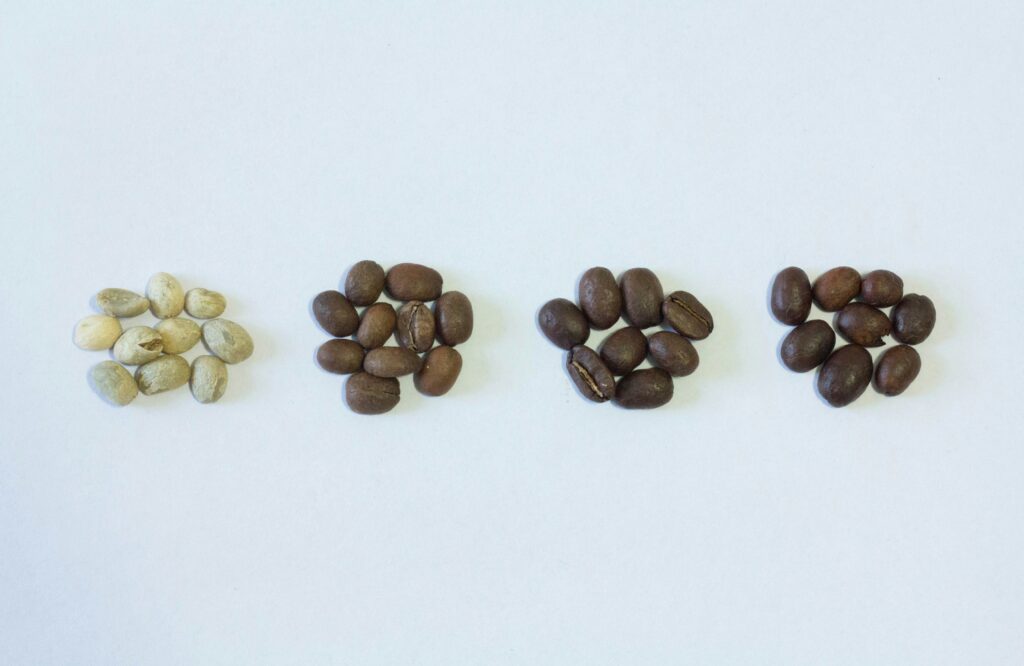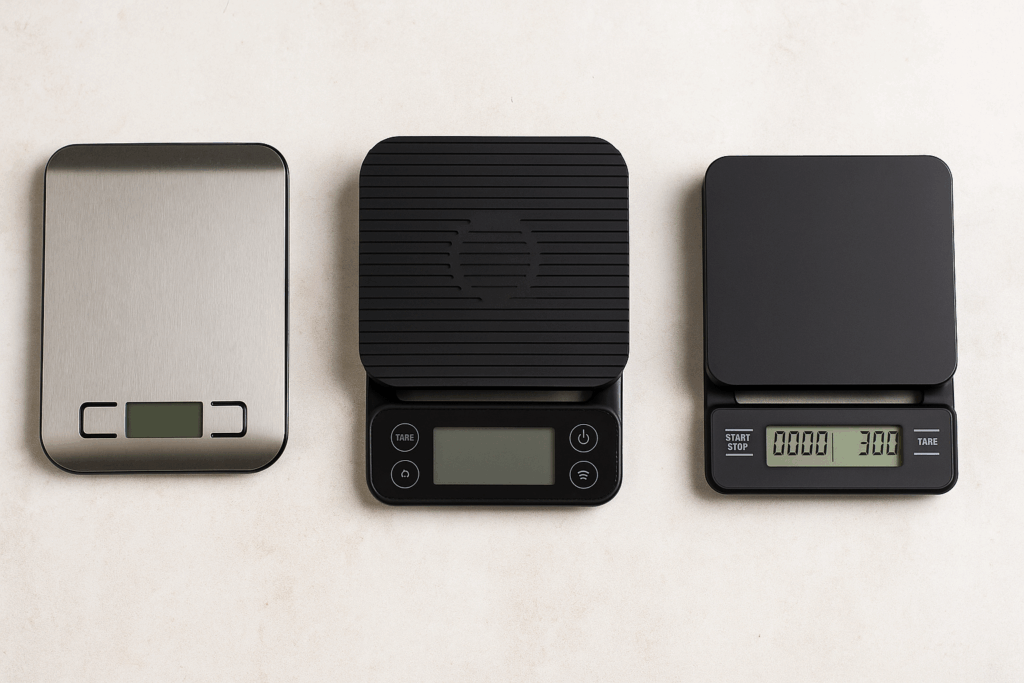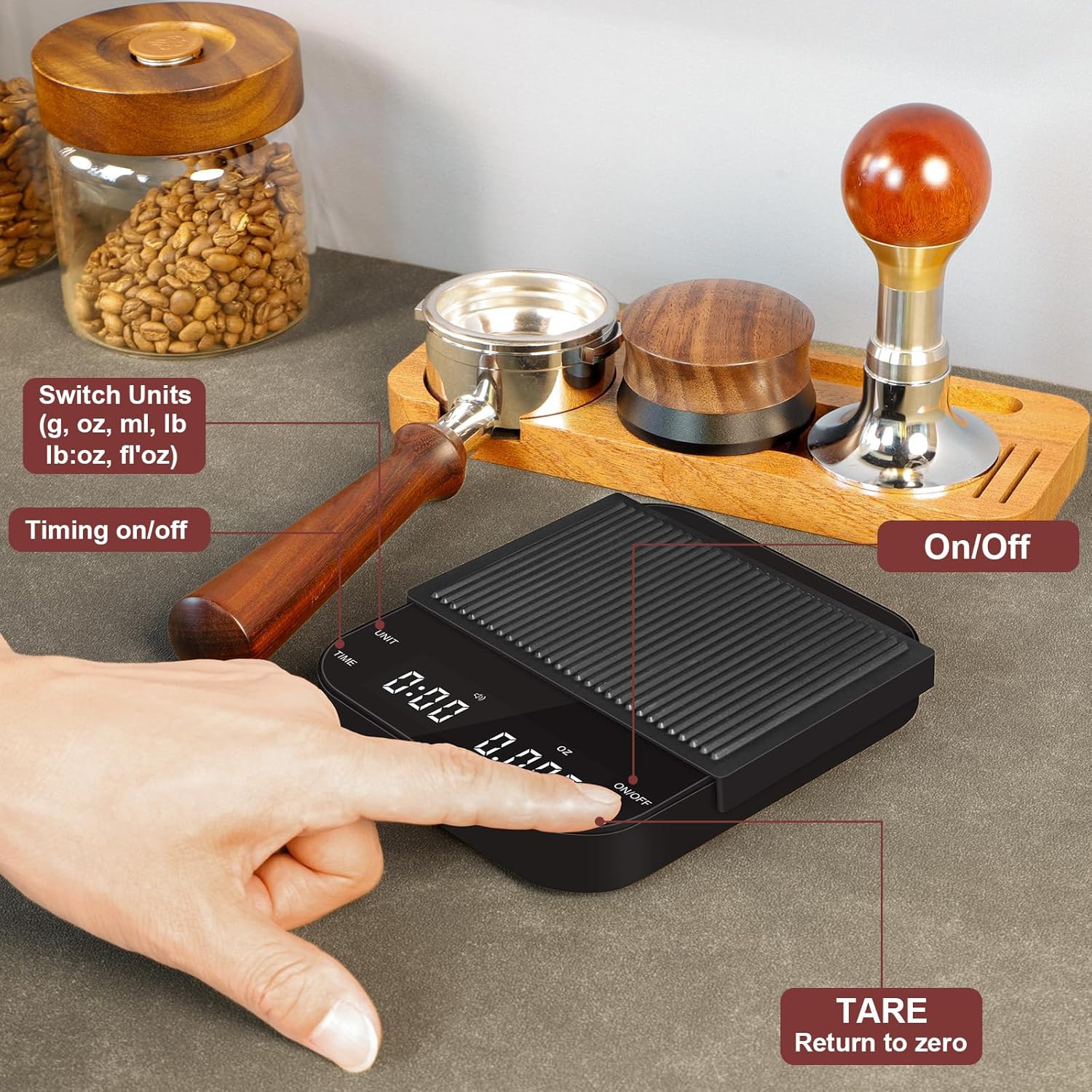If your morning coffee tastes rich and smooth one day but watery or bitter the next, the problem often isn’t your beans or machine – it’s how you measure your coffee. The debate of weighing coffee beans vs scooping is more important than most beginners realize. Most beginners scoop beans with a spoon or cup, thinking it’s “good enough.” But the truth is, scooping is highly inconsistent. If you want café-quality coffee at home,
weighing your coffee beans with a digital scale is the secret to achieving control, balance, and consistency in every cup. In this guide, we’ll explain why weighing coffee matters, what affects coffee weight, how to use a scale properly, and when it makes the most difference. Whether you’re brewing espresso, pour-over, or French press, this is your roadmap to brewing better coffee.
Table of Contents
Why Scooping Coffee Beans Is Unreliable
At first glance, scooping seems easy. You take a tablespoon, fill it with beans, and brew. But scooping measures volume (how much space something takes up), not weight (the actual mass of the coffee). Coffee brewing, however, depends on weight. Even small inconsistencies can ruin the balance of flavors.
- Bean density: Not all coffee beans weigh the same. Light roasts are denser (heavier for their size) because they retain more moisture. Dark roasts are lighter and puffier due to longer roasting, so a scoop of dark roast weighs less.
- Grind size differences: A scoop of fine espresso grind is more compact than a scoop of coarse French press grind. Same scoop, different weight.
- Scooping inconsistency: Depending on how you fill the scoop – heaping, leveling, shaking – you could have a 2-3 gram swing, which dramatically changes taste.
- Retention in grinder: Some coffee remains stuck inside your grinder (“retention”). If you scoop beans before grinding, you may not account for the few grams that stay behind, throwing off your recipe.

To put this into perspective: For espresso, just a 1-2 gram difference can turn your cup from rich and balanced to sour or bitter. That’s how sensitive coffee is to measurement.
Why Weighing Coffee Beans Matters
Using a digital scale shifts coffee brewing from guesswork to precision. Here’s why weighing wins:
- Consistency every time
When you stick to a reliable coffee-to-water ratio, such as 1:15 (1 g coffee to 15 g water), you can reproduce the same brew repeatedly. Scooping makes that impossible, since volumes vary with bean size, roast, and how tightly packed the scoop is. - Control over flavor
Want your coffee stronger? Add 1–2 grams. Prefer it lighter? Subtract a little. Weighing allows fine, repeatable adjustments rather than guess-and-check. - Adapts to different beans & roasts
Bean density changes with roast level and moisture content. A scoop of a light roast may weigh more or less than a scoop of a dark roast. Using weight ensures you’re getting the same amount of actual coffee, regardless of which beans you use. - Less waste and fewer failures
No more guessing and ending up with a weak or over-extracted cup that you throw away. You use just the amount you need for the recipe you trust. - Track grind retention & yield
Weigh the beans before grinding, then weigh the output (ground coffee). The difference is your grinder retention (coffee that stayed inside the grinder). Over time, you can calibrate or adjust to account for retention. This practice refines accuracy, especially for espresso.
Once you commit to weighing, the difference becomes obvious: you’ll consistently brew a more balanced, predictable, and café-level cup.
Key Factors That Affect Coffee Weight (and Taste)

Even when using a digital scale, it helps to understand why coffee weight changes and how these factors influence your brew. Here are the most important ones, explained with real examples:
- Coffee Bean Density
Roast level changes how heavy beans are. Light roasts are dense and compact because they retain more moisture from the raw green bean. Dark roasts, on the other hand, expand and lose water during roasting, making them lighter and more brittle. For example, one scoop of light roast might weigh 10 g, while the same scoop of dark roast might weigh 7 g. That’s nearly a 30% difference in strength if you measure by scoops instead of weight. - Grind Size
Grind size affects how tightly coffee packs together. Fine espresso grinds fit tightly in a scoop, while coarse French press grinds take up more space with air gaps. For example, a scoop of fine grind may weigh 12 g, while the same scoop of coarse grind may weigh 9 g. That’s enough to make one cup taste strong and another weak. - Grinder Retention
No grinder gives you 100% of what you put in. Some beans or grounds get stuck inside the burrs or chute – this is called retention. For example, you weigh 18 g of beans, grind them, and only 16 g comes out. That missing 2 g can cause your espresso shot to taste sour or under-extracted. By weighing both before and after grinding, you can account for retention and improve consistency. - Volume vs Weight
Scoops measure volume (space), while brewing depends on weight (mass). Two scoops may look identical but weigh differently depending on the bean type and grind. A digital scale removes this hidden variable. - Precision Scales with Timers
Advanced scales don’t just measure weight; many include a timer for tracking extraction time. This is especially useful for methods like pour-over, where both grams and seconds determine flavor. For example, for a 30 g pour-over recipe, you might aim to pour 450 g of water steadily over 2.5-3 minutes. Without weighing and timing, it’s almost impossible to hit both targets consistently.
Three Types of Coffee Scales

If you’re serious about making your coffee taste consistently great, the type of scale you use can make a big difference. The good news? You don’t need to spend a fortune. Whether you’re a beginner brewing a simple French press or an aspiring home barista fine-tuning espresso shots, there’s a scale that fits your style and budget. Choosing the right one will instantly give you more control, less waste, and better-tasting coffee.
Below is a quick comparison to help you decide which scale works best for you:
| Budget scales | Precision scales | Scales with timers | |
| Precision | Measures in whole grams only | Measures to 0.1 g (tenths of a gram) | Measures to 0.1 g and tracks brewing time |
| Best for | Beginners using French press or moka pot | Espresso lovers where small changes affect taste | Pour-over fans who want control over extraction |
| Pros | Affordable, simple to use, widely available | Great control, consistent shots, compact | Perfect for timing pours, combines two tools in one |
| Cons | Not precise enough for espresso, limited features | Costs more than basic scales, requires more attention | Slightly more expensive, not needed for casual brewing |
How to Use a Coffee Scale (Step-by-Step)
- Prepare your scale and container
Place a small, clean cup or bowl on the digital scale. This will be your container for weighing beans — it’s easier to transfer beans to the grinder this way than using your brewing equipment directly. - Tare (reset) the scale
Press the “tare” or “zero” button so the scale ignores the weight of the cup/bowl. This way, you’re only measuring the beans themselves. - Weigh your beans
Slowly add coffee beans into the cup until you reach your target weight. For example:
• 18 g for a standard espresso shot
• 30 g for a pour-over (like a V60)
• 60 g per liter of water for French press (rough guideline)
Tip: Write down your favorite recipes once you find your sweet spot – this helps you stay consistent. - Grind just before brewing
Transfer the beans from the cup to your grinder. Grinding immediately before brewing preserves freshness and aroma, since ground coffee starts losing flavor within minutes. - Brew and (optionally) use the timer
If your scale has a built-in timer, use it to track your brewing time:
• Espresso usually extracts in 25-30 seconds.
• Pour-over often takes 2-3 minutes.
• French press steeps for 4 minutes.
Tracking both weight and time helps you dial in flavor more precisely.
FAQs: Weighing Coffee Beans vs Scooping
Q: Do I really need a scale for French press?
A: Yes, while French press is more forgiving, weighing ensures balance and avoids weak or overly strong brews.
Q: What ratio should I use?
A: A common starting point is 1:15 (1 gram coffee to 15 grams water). For espresso, aim for 1:2.
Q: What if my grinder retains beans?
A: Weigh both before and after grinding to track retention. Over time, you’ll learn how much to add to compensate.
Q: Is a kitchen scale enough?
A: Yes, as long as it measures in grams. For espresso, consider a more precise scale.
Final Scoop: Weighing Wins
Scooping may feel easier, but weighing coffee beans is the proven way to unlock consistency, control, and café-quality flavor at home. By accounting for bean density, grind size, grinder retention, and time, you eliminate guesswork and gain mastery over your brew.
Ready to upgrade your coffee game? Check out this budget-friendly digital scale on Amazon. It’s a small investment that makes a big difference in every cup.

Want to dive deeper into brewing methods, gear tips, and beginner-friendly coffee hacks? Explore more guides on Yumm Coffee’s coffee blog – your go-to resource for learning how to level up your home coffee game.

Leave a Reply